Geobotany and Field Trips
Geobotany of Ohio and Batelle Darby Metro Park
Now you’ve heard of geology, and you’ve heard about botany, but what about a fusion of the two into a a field of study that will help us master the plants of the world (or at least Ohio)? Well, my friend, that concept is geobotany! Geobotany looks at plant communities and species in relationship to the substrates they grow on. Jane Forsyth, a pioneer of Geobotany, presented in her article, Linking Geology and Botany, the history of Ohio’s substrate and how the plant communities of Ohio reflect them. Here’s what I learned from her.
When taking a generalized view of Ohio’s geology, we can divide the state into two parts. In the western part of Ohio, the dominate substrate is limestone (and it’s variety dolomite). Because of its inability to resist the humid climate of Ohio, erosion has worn down the western lands and formed a rather flat landscape over a 200 million year time span. Eastern Ohio, on the other hand, has a mostly sandstone substrate that resists erosion by forming a natural cement. Erosion that does occur in this substrate usually occurs through water slowly dissolving the sandstone, creating deep valleys within hilly landscapes. So that’s why driving through western Ohio seems to present a mostly flat landscape, whereas eastern Ohio has steep-sided hills and valleys forged by rivers.
A perfectly reasonable explanation for the difference in dominate rock types between the eastern and western regions of Ohio rests in the original strata of sedimentary rock and natural pressures that moved said rock. In Ohio, thick layers of limestone originally formed, with shale and sandstone overlaying it, respectively. These layers were slowly pushed into a tilted arch from natural pressures that helped form the Appalachian Mountains 200 million years ago (and I though the pressure I felt from school was high)! The highest point of the arch falls in western Ohio, and erosion took a deep cut here, exposing the old limestone at the bottom of the sediment strata. Far from the height of the arch lies the areas of sandstone that were more resistant to erosion in the eastern part of Ohio.
What could’ve caused all this erosion across the state? But of course, the famous Teays River (pronounced “Taze”)–a preglacial stream that flowed through Ohio for approximately 200 million years, eroding the land throughout its existence. But what happened to this famous river that created steep valleys and flat uplands? Glaciers. The Ice Age glaciers advanced through Ohio, curtailing the river’s activities in their path.
Just a few hundred thousand years ago, the Pleistocene glaciers made their way to Ohio, only to be slowed down by the mighty steep hills of sandstone occupying the east (take that, glaciers!). Turns out the flat limestone landscapes were no match for the giant glaciers.
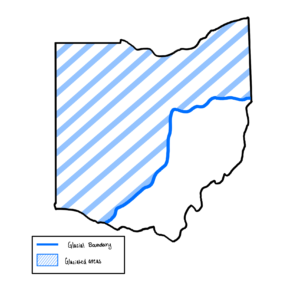
Map showing the glacier boundary of Ohio
During this time of invasion until about 20,000 years ago, the glaciers only further changed Ohio’s landscape. So, not only do we have this boundary of limestone versus sandstone substrate, but now also the glaciated versus unglaciated areas of the state, marked by a distinct boundary (as illustrated in my drawing).
As the glaciers crossed Ohio, they deposited till: an “unsorted mixture of sand, silt, clay, and boulders” that gathered as a result of melting glacial ice (Forsyth 2). This caused a blanket of these sediments to cover the glaciated areas of Ohio. (Sand and gravel deposits from the meltwater also formed from the glaciers, but are in local areas like river valleys or hills). Because the relative amounts of sediment in the till depended on the substrate over which the glaciers moved, the composition of the till varies across the state. In the western region of Ohio. the till has high amounts of lime and clay from the limestone the glaciers moved across. In eastern Ohio, the till has much less of these materials.
I think we’ve covered some basics on the geology, but what about the botany aspect of geobotany? I promise we’re getting there. Because of the aforementioned geological processes, western Ohio plains were left with a limy, clayey till. This substrate has an impermeable soil that is poorly drained and not well-aerated. However, the nutrients are plentiful! The pH is high and limy compared to the soils of eastern Ohio that lie on the permeable sandstone bedrock. This exposed substrate provides a permeable soil low in nutrients and very acidic.
Whew! That felt like a lot to digest, but it is worth it because now we can apply it to some plants I saw on our field trips!
5 species of trees/shrubs that have a distribution generally limited to limestone or limey substrates:
American Hackberry (Celtis occidentalis): With it’s weird warty bark and toothed, rough leaves, the hackberry is a pretty distinct tree to me. Often in floodplains, woods, and open areas of Ohio, the hackberry thrives in these poorly aerated, limy soils. We saw this cool tree near the Cedar Ridge Picnic Area of Batelle Darby Metro Park.
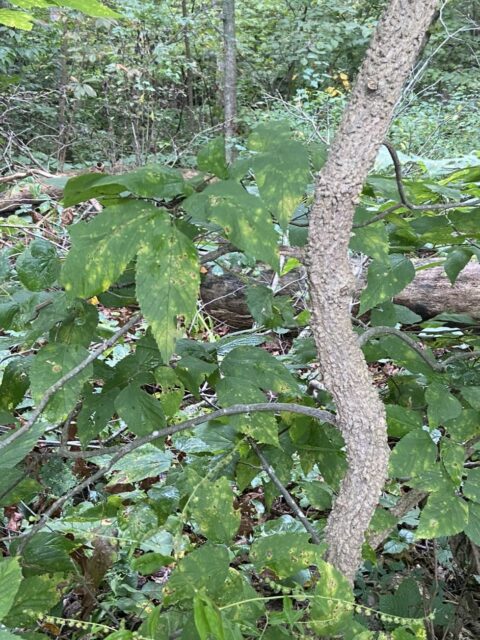
A look at the leaves and bark of the American Hackberry
Blue Ash (Fraxinus quadrangulata): This ash tree is pretty unique because of its twigs, which have a square-like cross-section and long lines trailing from the leaf scars. We also found this tree along the Batelle Darby picnic area because of those nice limy soils found there.
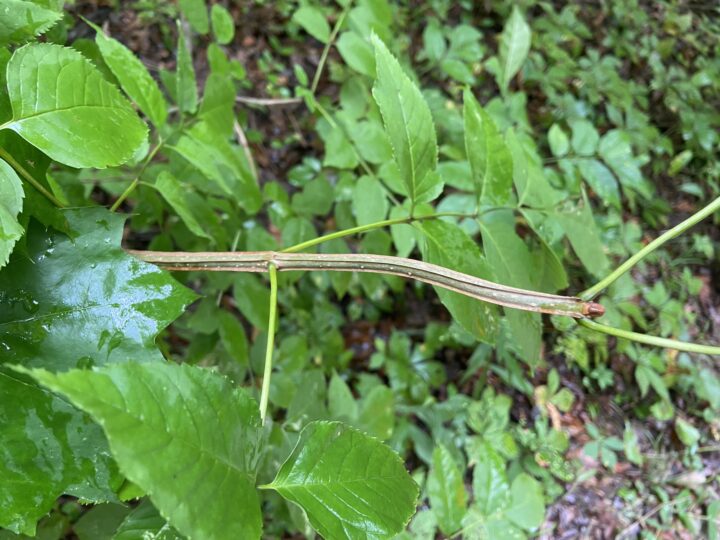
A nice look at the stem of the Blue Ash
Chinkapin Oak (Quercus muehlenbergii): Found this oak near Cedar Ridge picnic areas because it loves limestone soils. This tree has a medium size, with leaves sporting several pairs of sharp teeth. This tree is commonly found in higher abundance in limy substrates, but is not necessarily restricted to them.
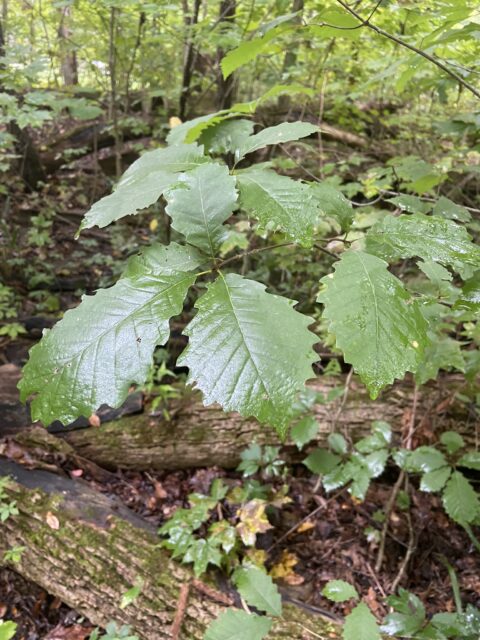
The sharp-toothed leaves from a chinkapin oak
Fragrant Sumac (Rhus aromatica): Another lover-of-limy-substrates is the fragrant sumac. This thornless trifoliate shrub has alternate leaves with large teeth. They produce a fragrant odor when crushed. This shrub likes sandy and rocky soils, just like the soils along the bank at Cedar Ridge.
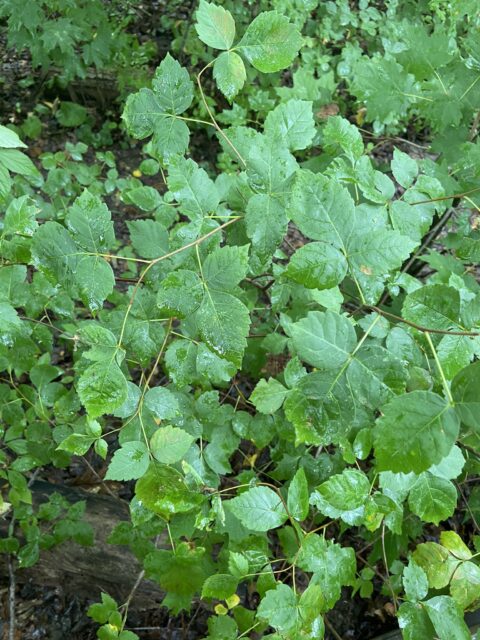
Trifoliate leaves of Fragrant Sumac
Hop Hornbeam (Ostrya virginiana): Found in fertile woods, just like those at Cedar Ridge, the hop hornbeam has some cool characteristics. The leaves are simple and serrated, and the bark is shreddy! It almost looks like my cat decided the trunk made a good scratching post (not to be confused with the American Hornbeam, whose bark looks muscly).
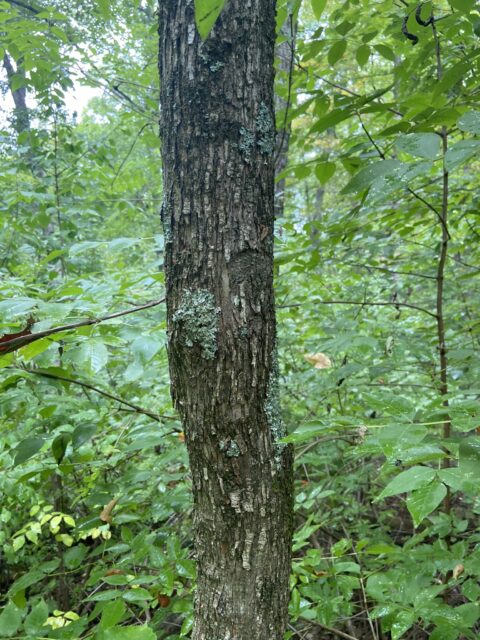
The shreddy bark of a hop hornbeam
5 species of trees/shrubs that have a distribution generally limited to high-lime, clay-rich substrates developed in the thick glacial till of western Ohio:
- Sugar Maple (Acer saccharum)
- American Beech (Fagus grandifolia)
- Shagbark Hickory (Carya ovata)
- Red oak (Quercus rubra)
- White Ash (Fraxinus americana)
5 species of trees/shrubs that have a distribution generally limited to sandstone hill of eastern Ohio:
- Chestnut Oak (Quercus montana)
- Greenbrier (Smilax glauca)
- Hemlock (Tsuga canadensis)
- Mountain Maple (Acer spicatum)
- Sourwood (Oxydendrum arboreum)
Substrate Picky Trees and Where to Find Them: Sweet Buckeye, Hemlock, and Rhododendron
Sweet buckeye (Aesculus flava) and Hemlock (Tsuga canadensis) are two trees that are found in the unglaciated areas of southeastern Ohio. Interestingly, sweet buckeye is majorly restricted to this unglaciated region, for reasons not quite known. Some think it may have to do with difficulty in re-population in the clayey, high-lime tills or maybe the climate. Hemlock, on the other hand, can extend north of the glacial boundary, but prefers cool, moist environments that the sandstone valleys of southeastern Ohio provide. The northern areas it occupies are likely possible due to deep valleys that open north, keeping the environment cooled and moist.
Rhododendron (Rhododendron maximum) is a species only found south of the glacial boundary. This species lived in the Appalachian highlands before the glacial invasion, and migrated down by means of the Teays Rivers mentioned earlier. After the glaciers thwarted the river’s drainage, the species could not thrive further than the glacial boundary. However, those that had already migrated via the Teays persisted.
All information regarding geobotany was derived from Jane Forsyth of Bowling Green University and her article Linking Geology and Botany…a new approach found here.
Cedar Bog (not a bog) and Scavenger Hunt
Batelle Darby Metro Park was lots of fun and helped me apply my new geobotany knowledge, but that wasn’t the only cool place we traveled to. We visited Cedar Bog (which isn’t a bog), and it was magnificent! So many cool plants and a cool ecosystem as well. Like I mentioned, Cedar Bog is not a bog but, in fact, a fen with a swampy forest. What’s the difference, you ask? Well, “fens flush and bogs clog!” Water from rainfall, upland runoff, filtered water from moraines (glacial hills) and groundwater from the ancient Teays River Valley enter the fen. Small streams and waterways in the fen flush the water through like a toilet. This flow of water contains dissolved limestone, creating a clear, alkaline to neutral environment that can support many unique plants. A bog, on the other hand, collects water through rainfall, where it sits until evaporated. This stagnant water allows dead plants to congregate and form peat layers. As this plant matter decays, the water become more acidic. I never would have known this if not for the wonderful interpretive signs at Cedar Bog!
Scavenger Hunt: Find two flowering species that are not in Asteraceae
For our field trip, we were each given a fun scavenger hunt prompt–a top secret mission, if you will. My mission, should I choose to accept it, was to find two species that were flowering. The catch: they could not belong to the Asteraceae family. I thought this mission was going to be a pain in the as…ster when all I could find flowering at Batelle Darby was a singular grass species and many, many Asters. But lo and behold, Cedar Bog surprised me with a wide array of flowering species that were really neat! So, I grabbed my Newcomb’s Wildflower Guide and set forth! Below you’ll find the results of my hunt!
Spotted Touch-me-not (Impatiens capensis): This plant has beautiful irregular orange flowers that are speckled with red-brown spots and alternately arranged leaves that are coarsely toothed. Each flower has a spur on the back curves inward, parallel to the flower. Touch-me-not, otherwise known as jewelweed, gets its name from its fruits. When you touch the pods of this plant, they expode! This is also why their genus name is Impatiens, which means “impatient” in Latin (Adirondacks Forever Wild). This flower is in the family Balsaminaceae.

A good look at the touch-me-not flower with apparent bilateral symmetry. The fruits can be seen hanging next to the flower in focus.
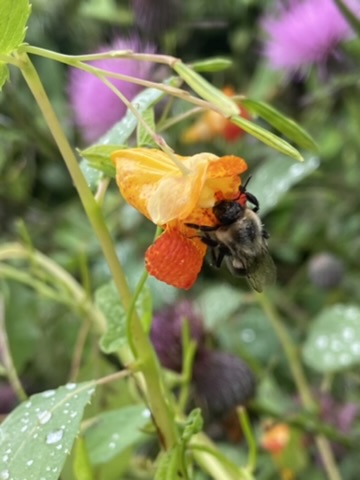
Obligatory bee pic! Bombus impatiens on an Impatiens capensis!
Great [Blue] Lobelia (Lobelia siphilitica): Another flower with bilateral symmetry, but this time its blue! These blue flowers have an upper and lower lip with 2 and 3 lobes, respecitively. The tube of the flower splits down the middle from the top lip. The leaves of this plant are also toothed and alternate, with a spike influorescence. The plant prefers these moist habitats, just like Cedar Bog (not a bog). The great lobelia has many medicinal properties, and Native Americans used it to cure many ailments, such as colds, headaches, and syphilis–hence, the name (Roots of Medicine).

A spike of great blue lobelia seen at Cedar Bog
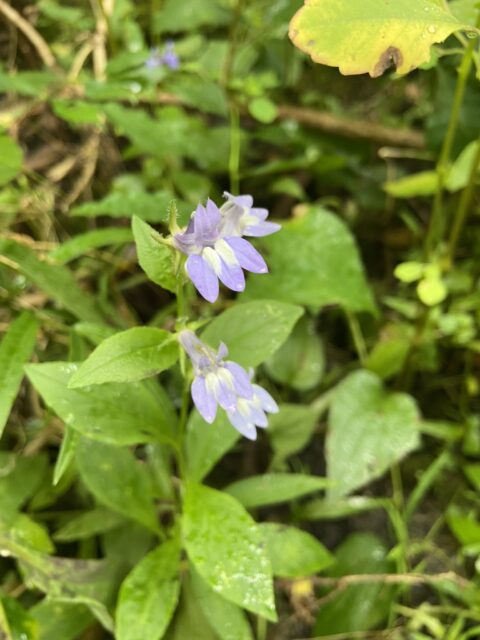
A closer look at the individual flowers. Despite the name, the flowers can look closer to a purple than a blue
Common Evening Primrose (Oenothera biennis): This time we have a radially symmetric flower with 4 yellow petals that are heart-shaped. It also has toothed alternate leaves. Some studies show that the oil from this plant could be used to treat eczema, headaches, and bruises (Lady Bird Johnson Wildflower Center).
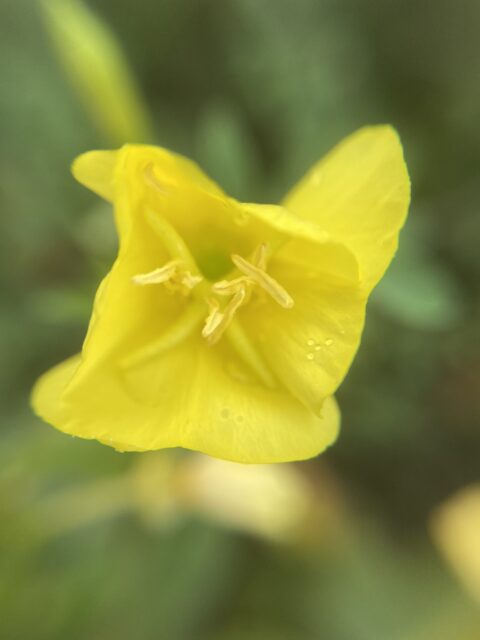
Not quite all the way open, because they open in the evening (that’s why its called evening primrose)
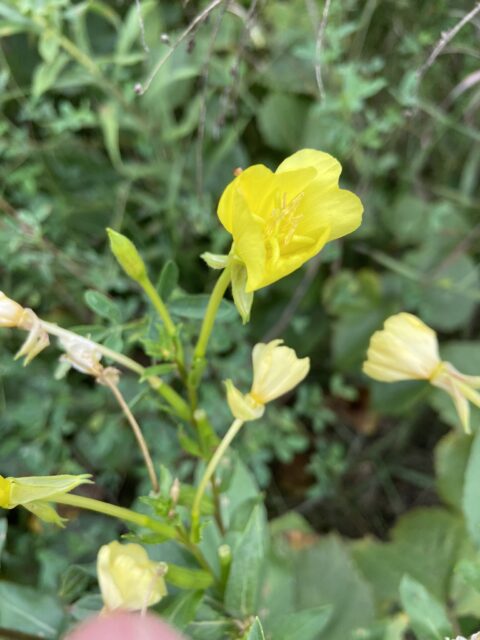
Evening Primrose from further back
Conservative Plants and CC Values
The Ohio Floristic Quality Assessment Index (OFQA) assigns a coefficient of conservation (CC) to each plant species, created by Andrea et al. (2002). The CC values describes the degree to which a plant species is associated with communities that are natural and high quality. In other words, it’s a weighted average, on a scale of 0-10, of how conservatie the species is in regard to the community in which it is found. Lower values are assigned to plants that can tolerate a wide range of habitats, where as high values describe plants that have a narrow range of ecological tolerance, indicative of higher quality habitat. Cedar Bog has a lot of rare species with high CC values. Here’s some I saw on our field trip:
10- Swamp Birch (Betula pumila): Swamp birch (or bog birch) has the high CC value of 10! This shrubby birch loves the calcium-rich soils of the fen–not bog–of Cedar Bog. It has double-toothed leaves that are alternately arranged on the twigs.
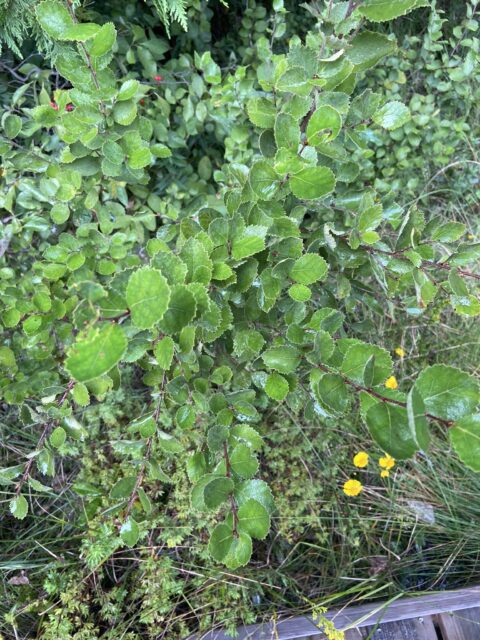
Swamp Birch shrub
10- Grass-of-Parnassus (Parnassia glauca): Grass-of-parnassus (not a grass) found at Cedar Bog (not a bog) has a CC value of 10! This white flower with its characteristic green veined-petals grows beautifuly in limy soils like those in the fen of Cedar Bog. Each stalk has a heart-shaped basal leaf clasping it.
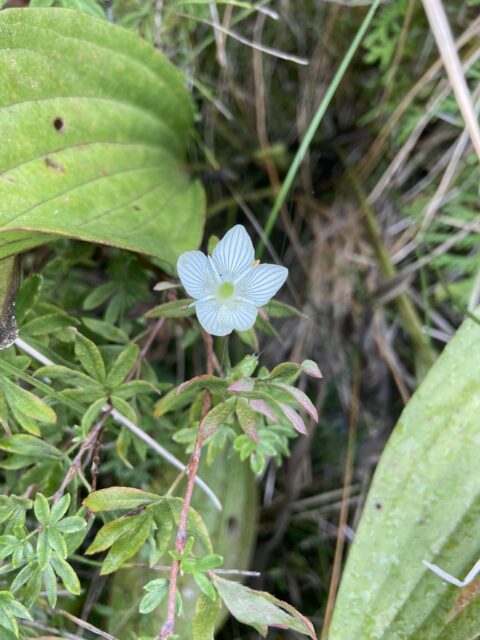
Grass-of-Parnassus featuring the stunning white flowers, striped with green
9- Ohio Goldenrod (Solidago ohioensis): There are lots of goldenrods in Ohio, but this one has a high CC of 9! This particular goldenrod has smooth, lance-like leaves.
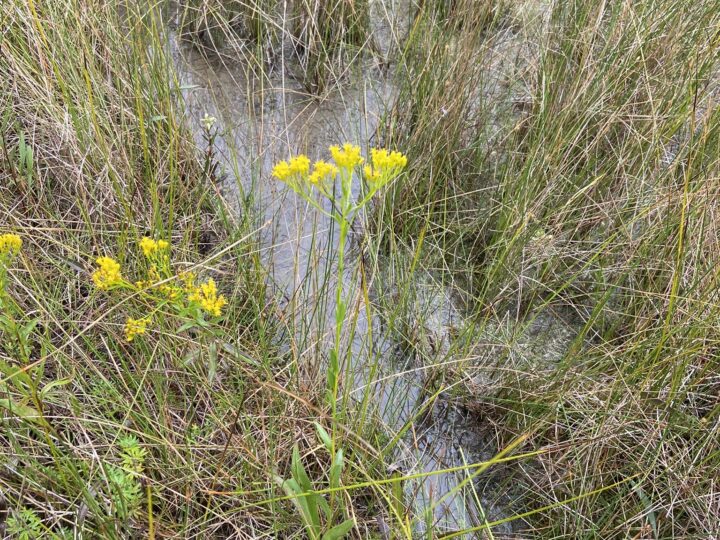
Appearing to have a flat top, the bright yellow stands out in the wet meadow
9- Bog Goldenrod (Solidago uliginosa): Another goldenrod with a CC of 9–wow! This bog goldenrod (also called swamp goldenrod) is usually found in swamps, fens (like Cedar Bog), and bogs, as the name suggests. Compared to the Ohio goldenrod, these flowers form a wand-like shape rather than a flat top.
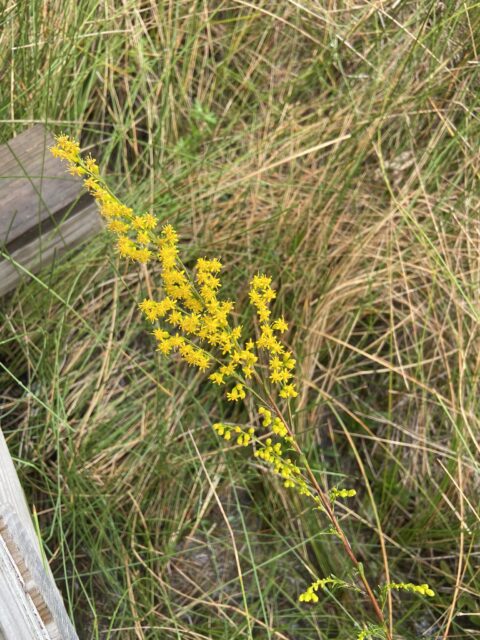
Wand-like appearance of bog goldenrod
7- Round-leaved Sundew (Drosunda rotundifolia): This plant was probably one of my favorites with a CC of 7. It is round-leaved sundew, a CARNIVOROUS plant! The hairs on the leaves of this plant secrete little drops of sticky fluid that attracts insects, luring and trapping them. Pretty cool.
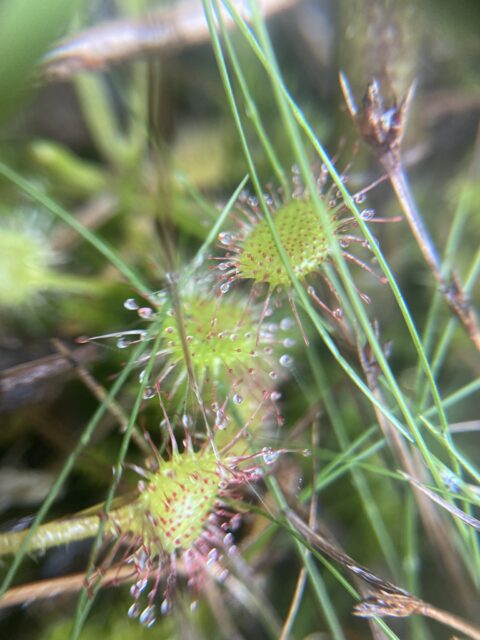
A magnified view of the sundew. You can even see the little dew drops on the leaf hairs
7- Poison Sumac (Toxicodendron vernix): While its neat that this plant has a high CC of 7, it’s not neat that every part of Poison Sumac is an irritant. Good thing we learned to identify it (phew)!

This shrub has 7-13 entire leaflets. But no touchy!
Invasives…Boo
Despite all the cool plants we saw with high CC values, we also saw some invasive plants between Cedar Bog and Batelle Darby Metro Park. Here are some that we found:
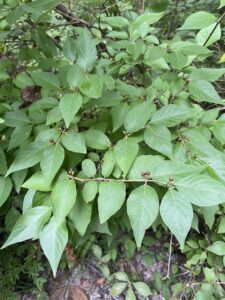
Amur Honeysuckle (Lonicera maackii)
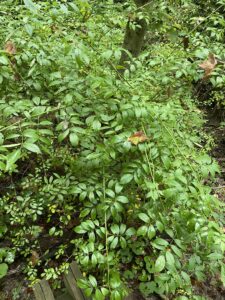
Multiflora rose (Rosa multiflora)
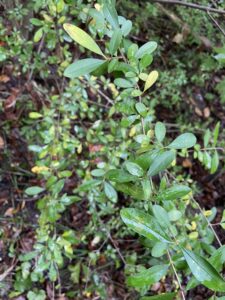
Privet (Ligustrum spp.)
